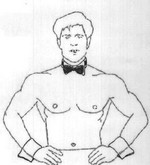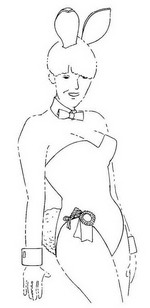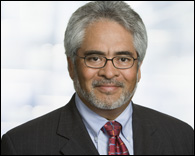In re Chippendales USA, Inc. (Fed. Cir. 2010)
 The first Chippendales club opened in Los Angeles in 1978. The following year, on-stage performers began wearing their now well-known Cuffs & Collar costumes. In 2003, the USPTO agreed that the trade-dress had acquired distinctiveness and issued Trademark Registration No. 2,694,613. (Chippendales had argued that the mark was also inherently distinctive, but the examiner had rejected that argument.) In 2008, the original mark became “incontestable.”
The first Chippendales club opened in Los Angeles in 1978. The following year, on-stage performers began wearing their now well-known Cuffs & Collar costumes. In 2003, the USPTO agreed that the trade-dress had acquired distinctiveness and issued Trademark Registration No. 2,694,613. (Chippendales had argued that the mark was also inherently distinctive, but the examiner had rejected that argument.) In 2008, the original mark became “incontestable.”
 This case arose in 2005 when Chippendales requested a new registratation for the same mark based upon its inherent distinctiveness. (The company wanted to strengthen its mark.) The Tradmark Trial and Appeal Board ruled against Chippendales — finding that the mark was not inherently distinctive. In particular, the Board noted that strippers often wear revealing would-be professional costumes such as a stethoscope, utility belt, or chaps with a ten-gallon hat. In this case, the Chippendales Cuffs & Collar costume appears directly derived from a Playboy Bunny costume. Based on these facts, the Board held that the Chippendales outfit failed the test for inherently distinctive trade dress outlined in Seabrook (CCPA 1977).
This case arose in 2005 when Chippendales requested a new registratation for the same mark based upon its inherent distinctiveness. (The company wanted to strengthen its mark.) The Tradmark Trial and Appeal Board ruled against Chippendales — finding that the mark was not inherently distinctive. In particular, the Board noted that strippers often wear revealing would-be professional costumes such as a stethoscope, utility belt, or chaps with a ten-gallon hat. In this case, the Chippendales Cuffs & Collar costume appears directly derived from a Playboy Bunny costume. Based on these facts, the Board held that the Chippendales outfit failed the test for inherently distinctive trade dress outlined in Seabrook (CCPA 1977).
On appeal, the Federal Circuit first looked to determine whether the costume is part of the product design or only product packaging. That distinction is legally important because of the Supreme Court ruling in Wal-Mart v. Samara Bros (2000) that product design is never inherently distinctive. Here, the court held that the costume is product packaging — with the product being “adult entertainment services.”
The Appellate Court then walked through each of the three relevant Seabrook elements:
- Whether the mark is a common shape or design;
- Whether the mark is unique or unusual in the particular field;
- Whether the mark is a mere refinement of a commonly adopted and well-known form of ornamentation for a particular class of goods or services viewed by the public as a dress or ornamentation for the goods or services; or
- Whether the mark is capable of creating a commercial impression distinct from any accompanying words. (This fourth element was held irrelevant in this case.)
Here, the Appellate Court rejected the Board’s implicit holding that no costume on an adult entertainer could be inherently distinctive. However, the Appellate Court agreed with the Board that the Cuffs & Collar costume was a “mere refinement” of the well-known Playboy Bunny costume. As a result, the Cuffs & Collar costume failed the third Seabrook element and therefore lacks inherent distinctiveness.
The use of the Playboy mark constitutes substantial evidence supporting the Board’s determination that Chippendales’ Cuffs & Collar mark is not inherently distinctive. The Playboy bunny suit, including cuffs and a collar, was widely used for almost twenty years before Chippendales’ first use of its Cuffs & Collar trade dress. The Cuffs & Collar mark is very similar to the Playboy bunny costume, although the Cuffs & Collar mark in-cludes no bunny ears and includes a bare-chested man instead of a woman in a corset. While the Playboy clubs themselves did not involve exotic dancing, the mark was registered for “operating establishments which feature food, drink and entertainment.” The Cuffs & Collar mark was also worn by waiters and bartenders at Chippendales establishments, which Chippendales argues reinforced the association of the mark with the Chippendales brand. Additionally, the pervasive association between the Playboy brand and adult entertainment at the time of the Board’s decision leads us to conclude that the Board did not err in considering the mark to be within the relevant field of use. Thus, the Playboy registrations constitute substantial evidence supporting the Board’s factual determination that Chippendales’ Cuffs & Collar mark is not inherently distinctive under the Seabrook test.
In its brief, Chippendales argues that Wal-Mart v. Samara is at odds with Seabrook and that the Seabrook should therefore be revisited. The Federal Circuit rejected that suggestion.
 President Obama has announced the nomination of Jimmie V. Reyna to fill the open slot on the Court of Appeals for the Federal Circuit that was created when
President Obama has announced the nomination of Jimmie V. Reyna to fill the open slot on the Court of Appeals for the Federal Circuit that was created when  USPTO Technical Training for Examiners: The USPTO is looking for folks to provide free scientific & technical training to examiners. The program does not allow guest lecturers to discuss their own pending applications or provide advice on the patentability of any particular claims. [
USPTO Technical Training for Examiners: The USPTO is looking for folks to provide free scientific & technical training to examiners. The program does not allow guest lecturers to discuss their own pending applications or provide advice on the patentability of any particular claims. [